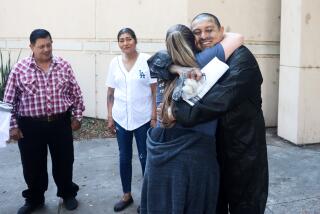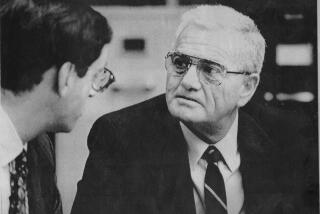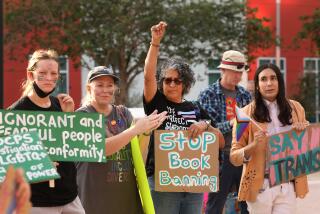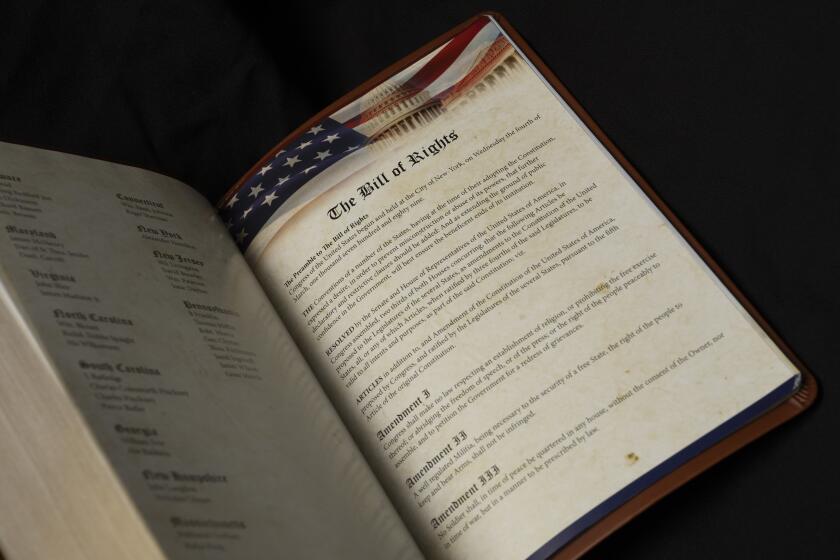Experts Fault McMartin Child Interview Methods
There are many things to be learned from the McMartin Pre-School molestation case, but perhaps the most important lesson of all is how not to talk to children, according to top child-development experts.
Experts across the country say the interview techniques intended to extract the truth from youngsters who attended the Manhattan Beach nursery school were so misguided as to make the children seem coerced, rehearsed and ultimately unbelievable to the jury. And last Thursday, the jury acquitted Ray Buckey and his mother, Peggy McMartin Buckey, of 52 counts of child molestation.
According to both child development and criminal defense experts who have closely monitored the case for the last six years, some of the adults--the parents, the prosecutors, the therapists--who tried hardest to find out what happened in the first place may have done the most to confuse the case in the end. While the prosecution’s approach will surely be subjected to ongoing attacks of second-guessing and Monday morning quarterbacking, in the long run it will be the conversations with the children that were the most confusing, the most damaging.
“If I had to do it over again, I would do some things differently,” Kee McFarlane, the social worker at the Children’s Institute International who interviewed many of the children, told The Times on Wednesday.
The problem, according to the experts, was that most of the children were never given the chance to simply tell what, if anything, happened to them.
“They were never given the opportunity to tell their stories as they knew them, in their own words, until long after their minds had been contaminated with the thoughts and fears of the adults around them,” said David Raskin, a psychologist at the University of Utah who has been studying child abuse cases for the last 15 years. By then, he said, it was too late.
Although the questioning process worked differently for each of the 360 children who eventually claimed to have been sexually molested, in many instances it was the parents who first talked to their own children, followed by the police. Eventually most of the children were referred to the Children’s Institute International, an established child-abuse treatment center in Los Angeles that had much experience with abused children but little or no knowledge of the judicial system.
McFarlane summed up the institute’s approach this way: Because of their fears about what their parents would think and what the police would do, because of their terror about what their perpetrators had supposedly done already, the children had to be helped, they had to be taken by the hand and persuaded that it was “all right to tell their yucky secrets.”
If she were doing it again, McFarlane said, she would move more slowly, giving the chlidren time to say whatever it is they wanted to say in their own words. The problem, she said, was that there were so many cases. (The institute interviewed 400 children.) And there was much pressure to get through with it, to get on with it.
Given the choice, she said, she might not do it at all--at least she would not put herself in the position of being both therapist and investigator.
“You can’t do both, not at the same time,” McFarlane said in a telephone interview from San Francisco, where she said she has gone to rest and reflect on what went wrong with the case from the prosecution’s--and the children’s--point of view.
“The unfortunate thing about what happened in the McMartin case is that we were forced to do both,” McFarlane said. “We were gathering information for lawyers while at the same time we were just trying to get these children through their fears.”
A therapist’s or social worker’s goal is to understand “the subjective reality” of the patient, to understand his fears and fantasies, Raskin said.
An investigator’s job is to deal only with reality, “the truth as it actually happened,” not as it was feared or imagined, Raskin said. These two goals are completely in conflict, he said.
Just because the interviews were conducted as they were does not mean that the crimes did not occur, said Faye Girsh, a San Diego therapist. It simply means that “it will be impossible for anyone ever to know for certain exactly what did--and what did not--happen” at the McMartin school, said Girsh, who has worked on numerous child-abuse cases that have been successfully prosecuted, including a recent one involving 26 children in a Montessori day school baby-sitting service in Reno, Nev.
By comparing cases that have been successfully prosecuted with those that have not, social scientists have tried to glean information about how children talk, how they think--and what will hold up in court.
“The only thing we agree on across the board is that the way it was done in the McMartin case is not the way it should be done. Beyond that, there isn’t a lot of agreement among experts about what is right and what isn’t,” said one child-abuse specialist, who, like most of the nationally known figures in the field, was drawn into the case as a consultant.
Many Questions Remain
Since the McMartin case began, dozens of books have been written and hundreds of workshops and seminars have been conducted across the country to try to teach mental-health specialists something about how the judicial system operates and to teach lawyers and police officers something of how the mind of a child works. But many questions remain on both sides.
Although some experts continue to believe that child molestation is under-reported, some law-enforcement officers and a growing number of child-abuse experts believe that the United States may be suffering from mass hysteria about child abuse--a hysteria that is now infecting the minds of the children who are not developmentally equipped to distinguish between truth and lie, fact and fantasy.
The other side of the problem is that actual child molesters are extremely hard to identify.
In the behavioral sciences unit at the FBI Academy in Quantico, Va., profiles of child molesters have been developed. Unlike drug traffickers or other high-profile criminals, child molesters are often model citizens, hard-working, successful professionals, usually men, who are unusually kind to children and have no apparent sign of mental illness, other than their abnormal sexual attraction to children.
“That’s why they are so scary,” said Girsh, who in her practice has treated many perpetrators of incest and pedophiles, the medical term for child molesters.
But researchers have also been observing parents as well as perpetrators. And what they are seeing is nearly as chilling.
Even when parents simply suspect that their child has been abused, they behave in ways that can also harm the children. Sometimes parents react with such horror and disbelief that they do not give the children any support and they do not even allow them the opportunity to say whether anything really happened.
In other cases, parents become so obsessed with their own worries that they badger their children to the point they begin to think something untoward or awful has happened, even when it really has not.
There are researchers who believe that children, because of their vulnerability and their dependency on adults, can in effect be brainwashed by an unending barrage of questions, allegations and innuendoes.
But there are other experts who believe that this line of reasoning is preposterous.
Not Equipped to Lie
Children, these researchers insist, cannot tell a lie, at least not about something as painful and unfamiliar as sexual abuse. They have neither the experience, the incentive nor the language to do so.
Many of these arguments are based on years of study by prominent researchers in the field, most notably Gail Goodman, a development psychologist at the State University of New York at Buffalo, and Karen Saywitz, director of children’s psychological outpatient services at Harbor-UCLA Medical Center.
Working under grants from the U.S. Justice Department, the National Center on Child Abuse and Neglect and other organizations, these researchers have found that while children, especially children the age of those who attended the McMartin Pre-School, can and will fabricate a wrong answer to a question, they are not able to fabricate details.
One of the unfortunate by-products of the nation’s war on child abuse, however, is that children at younger and younger ages are learning more and more about child abuse.
Girsh tells the story of a case in San Diego involving a recently divorced couple whose 6-year-old daughter accused the father, a prominent and respected lawyer, of sexual abuse. The child insisted that she knew the difference between truth and lie, between fact and fantasy. True, she knew the words. But she also insisted in court that she had seen the tooth fairy.
In the end, the judge and jury learned that her mother had recently read her a book on child molestation, which the child, for whatever reasons, had committed to memory. What she had told her mother and the prosecutors was not what she had actually experienced in real life but what she learned from a book.
If an interview is conducted properly--meaning that children are given the time and the encouragement to talk, but are not told what to say or what others have said before them--they will eventually tell the truth, many researchers believe.
The question is how to get it.
Some studies have shown that the more serious the interviewer is, the more likely the child will be to tell the truth. But other studies have suggested that the colder and more emotionally remote the interviewer, the more likely the child will be to say what he or she believes the interviewer wants to hear.
One of the controversial techniques, one used in the McMartin case, involves playing on the floor with the children and using dolls and puppets. Critics say such practices demean children, compromise the seriousness of the task and lead to more fantasy playing than fact telling. Others say it is necessary to put the children at ease, although even proponents acknowledge that too much should not be read into what children do with dolls.
As one child-abuse expert put it, “The dolls are not lie detectors; they are communication tools.”
What is most important, according to many experts, is understanding the language children speak.
“If you start using works like, ‘under’ or ‘against’ or ‘on top of’ or ‘inside,’ you’d better know ahead of time that children actually know what those prepositions mean,” said Laurie Braga, a psychologist at the University of Miami Medical School, who, along with her husband, Joseph, helped prosecutors by interviewing dozens of sexually abused children in a day-care center in Miami in the early 1980s.
That case--which was the subject of a book, “Unspeakable Acts” by Jan Hollingsworth, and a television docudrama--resulted in what is said to be the first successful prosecution in the nation of a day-care center operator on multiple abuse charges.
It is also critical, Laurie Braga said, to understand something about child development. What do children know? What can they remember?
You cannot, for example, ask a 3-year-old whether something happened within the last 30 days or even within the last 30 minutes. They don’t even know how to tell time.
A common theme voiced by many child-abuse experts is just how poorly equipped the American courtroom is to deal with accusations from children.
“In our judicial system, we are not allowed to ask ‘leading’ questions,” said Ann Uherek, a psychologist at Harbor-UCLA Medical Center, who has provided therapy for 12 McMartin students and 38 other children enrolled in five nearby schools who had also claimed to be abused.
Uherek said the typical question in an American court of law is worded this way: “Tell us what happened on the morning of April 19, 1989.” That is not a question a 3-year-old or a 4-year-old or even a 9-year-old can answer, she added.
Although California and other states have exceptions in their codes of evidence that make some allowances for children, many experts believe that the courts have not gone far enough in accommodating children. There have been some efforts to reform the system, including an experiment in Denver where judges bring children into their private chambers, sit them on their knees and listen to what they have to say.
Some states, California included, have also passed laws allowing testimony to be taken in private, on closed circuit television, so small children are spared the trauma of appearing before their alleged abusers.
The American judicial system insists that the accused be allowed to face his accuser. But when dealing with children, Uherek said, that system simply does not work. “It may be fine for adults,” she said, “but not for children, who are susceptible to magical thinking . . . who believe that simply by having to face their perpetrator, they will be harmed or even killed.”
“In one sense,” Joseph Braga said, “there may be a great deal of historical significance in these child-abuse cases because we are beginning to define what are the needs, what are the capabilities of young children.”
The unfortunate thing, according to many experts, is that many people are inexperienced in this new field and are operating by the seat of their pants.
As far as many child-abuse experts are concerned, however, there is a bitter irony in all the criticism that has been lodged against McFarlane and others like her who have tried to help children tell painful stories about what adults have done to them.
Unlike rape cases, in which the victim is often blamed for what may or may not have happened, it is the therapist in child-abuse cases who gets the brunt of the criticism.
We cannot bring ourselves to blame innocent children, the experts say, but we certainly can and do blame the adults who helped the children to tell their stories. It is, Joseph Braga said, a new form of an ancient practice: Killing the messenger because you don’t like the message.
More to Read
Sign up for Essential California
The most important California stories and recommendations in your inbox every morning.
You may occasionally receive promotional content from the Los Angeles Times.










